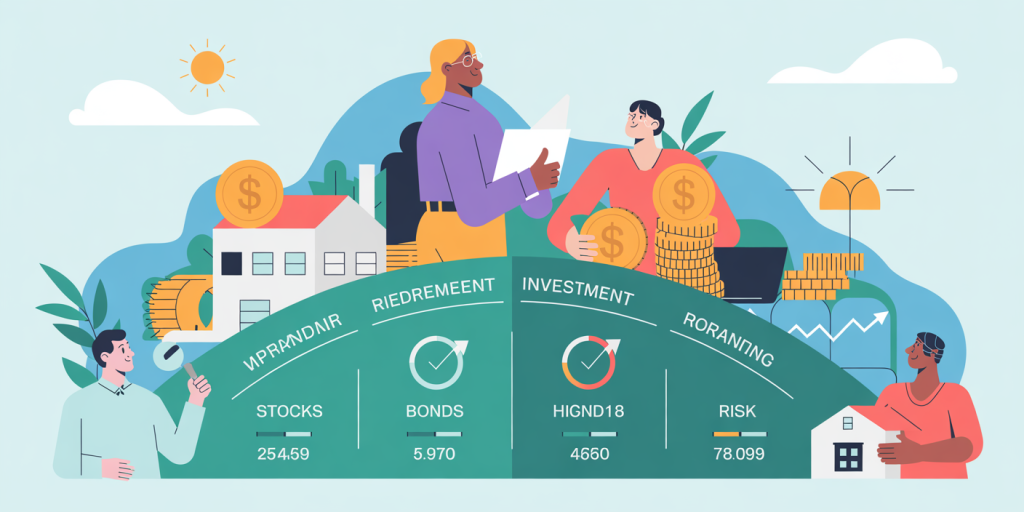Retirement Investments: Where to Put Your Money for the Long Term
Anúncios
Planning for retirement is a crucial financial goal that requires deliberate investment strategies tailored for long-term growth and stability. With increasing life expectancy and evolving economic conditions, choosing the right investment vehicles for your retirement savings is more important than ever. This article explores various retirement investment options, analyzes their risks and returns, and offers practical guidance to help individuals secure a financially stable retirement.
Understanding Retirement Investment Goals
Anúncios
Retirement investments are fundamentally different from short-term financial planning. The primary objective is to grow assets steadily over decades while managing risks prudently. Unlike speculative ventures or short-term trades, retirement portfolios should balance capital preservation, inflation protection, and income generation.
Consider Jane, a 35-year-old professional aiming to retire at 65. Her investment horizon is 30 years, which allows for more aggressive growth-oriented strategies initially. Contrast this with Mark, who is 60 and planning to retire in five years. Mark’s focus should be on preserving capital and ensuring liquidity. These distinct needs highlight the importance of reserving retirement investments based on one’s timeline and risk tolerance.
According to the Employee Benefit Research Institute, about 40% of Americans risk outliving their retirement savings due to inadequate investment growth or poor planning. This underscores the necessity of informed decisions regarding where to allocate funds to optimize returns and protect wealth.
Stocks: Growth Potential with Volatility
Stocks are often considered a cornerstone of retirement portfolios due to their potential for substantial growth. Over the past century, the S&P 500 has yielded an average annual return of approximately 10%, outpacing most other asset classes.
For example, Buffett Partnership, led by Warren Buffett in the 1950s-60s, consistently achieved outsized returns through value investing principles. His strategy focused on identifying undervalued companies with strong fundamentals, a practice that many retirement investors emulate today.
However, stocks come with inherent volatility, which can jeopardize short-term gains. A 2008 market crash demonstrated how reliance solely on equities could erode retirement accounts dramatically during market downturns. Therefore, younger investors with longer horizons might allocate a higher percentage to stocks, gradually shifting to safer assets as retirement nears.
A comparative table below summarizes the benefits and risks:
| Aspect | Stocks | Bonds |
|---|---|---|
| Average Annual Return | ~10% | ~3-5% |
| Risk Level | High (market volatility) | Moderate to low (interest rate risk) |
| Income Generation | Dividends (variable) | Fixed interest payments |
| Liquidity | High | High (depends on bond type) |
| Best For | Long-term growth | Capital preservation and income generation |
Bonds and Fixed Income: Stability and Predictability
For many nearing retirement, bonds and fixed-income securities provide essential portfolio stability. Bonds typically offer fixed interest payments and return the principal at maturity, which can protect against market volatility.
Take the case of Susan, a 58-year-old nearing retirement, who shifted part of her portfolio into municipal and treasury bonds. This adjustment reduced her portfolio’s volatility and secured predictable income, helping her withstand the COVID-19 market shocks in 2020 without severe losses.
Corporate bonds, government bonds, and municipal bonds each have different risk-return profiles. U.S. Treasury bonds are considered one of the safest investments, supported by the government’s creditworthiness. Municipal bonds may offer tax advantages but typically carry slightly higher risk than Treasuries.
Recent data from Bloomberg shows that 10-year U.S. Treasury yields have fluctuated between 0.5% and 3% over the last decade, reflecting a low-interest environment. This challenges investors to balance the need for income with the current low yields, often pushing them toward higher-yielding corporate or international bonds.
Real Estate Investments: Tangible Assets with Income Potential
Real estate is a time-tested retirement investment known for its dual benefits of capital appreciation and rental income. Properties in growing urban areas offer potential for value increases over years, while rental units generate steady cash flow.
Consider the example of retirees who invested in rental properties in Sun Belt cities like Austin, Texas, over the past 10 years. These properties appreciated significantly due to population growth and economic expansion. Simultaneously, rental demand remained robust, ensuring consistent income.
Real estate investment trusts (REITs) offer an alternative for those who want exposure without the hassles of direct property management. REITs are publicly traded on stock exchanges, offering liquidity and dividend yields typically ranging from 3% to 7%, depending on the sector (commercial, residential, healthcare).
Despite the benefits, real estate comes with risks such as market downturns, maintenance costs, and illiquidity in direct property investments. Diversification within real estate sectors and geographical locations can mitigate some of these risks.
| Real Estate Investment Type | Advantages | Disadvantages | Typical Yield (%) |
|---|---|---|---|
| Direct Ownership | Tangible asset, rental income | Management required, illiquid | 6-12 (depending on market) |
| REITs | Liquidity, diversification | Market volatility, less control | 3-7 |
Mutual Funds and ETFs: Diversification Made Easy
Mutual funds and exchange-traded funds (ETFs) are popular investment vehicles among retirement savers due to their diversification and professional management. These funds pool money from investors to buy a broad portfolio of assets, mitigating the risk associated with single-stock picking.
John, a 40-year-old investor, prefers using a target-date mutual fund for retirement. These funds automatically adjust asset allocation from higher-risk stocks to conservative bonds as the target retirement date approaches, simplifying investment decisions.
ETFs, trading like stocks, often come with lower expense ratios and greater tax efficiency. In recent years, the rise of index ETFs tracking benchmarks like the S&P 500 or Nasdaq has provided cost-effective exposure to major market indices.
According to Morningstar, index funds and ETFs have grown to dominate retirement accounts, accounting for over 50% of 401(k) assets. This reflects investor preference for low-cost, diversified options amid volatility.
| Fund Type | Expense Ratio (%) | Typical Holdings | Best For |
|---|---|---|---|
| Actively Managed Mutual Fund | 0.5 – 1.5 | Mixed (stocks, bonds) | Investors seeking active management |
| Index Mutual Fund | 0.1 – 0.3 | Market index stocks | Cost-conscious, passive investors |
| ETF | 0.03 – 0.5 | Stocks, bonds, commodities | Investors wanting liquidity and low fees |
Alternative Investments: Diversifying Beyond Traditional Assets
Besides conventional stocks, bonds, and real estate, some retirement portfolios include alternative investments such as commodities, private equity, or annuities. While riskier or less liquid, these options can provide additional diversification and income streams.
For instance, annuities offer guaranteed income for life but may come with high fees or reduced liquidity. Commodities like gold serve as an inflation hedge but tend to lack income generation. Private equity investments, accessible mostly to high-net-worth individuals, can yield high returns but require long commitment periods.
An illustrative case is Robert, who incorporated a small allocation (around 10%) into gold and annuities in his late 50s. This provided him inflation protection and a steady payout, supplementing his diversified portfolio.
Investors should assess alternative investments carefully, considering fees, liquidity, risk, and alignment with retirement goals and timelines.
Future Perspectives: Navigating Retirement Investments in a Changing Landscape
The retirement investment landscape is evolving rapidly, influenced by demographic shifts, technological advancements, and fluctuating economic conditions. Increasing life expectancy—projected by the CDC to reach an average of 77 years in the U.S.—means retirees need their investments to support longer retirement periods, requiring sustained growth and income.
Additionally, environmental, social, and governance (ESG) factors are becoming increasingly significant. Sustainable and socially responsible investing is attracting more retirement investors, as studies by Morgan Stanley reveal that ESG funds often perform comparably or better than traditional funds, providing both ethical and financial rewards.

Technological innovation, including robo-advisors and AI-driven financial planning tools, is democratizing access to sophisticated portfolio construction and rebalancing strategies. These solutions help individuals tailor retirement portfolios with optimized risk-return profiles based on personalized data and market conditions.

Inflationary pressures and global geopolitical risks will also shape investment choices. For instance, Treasury Inflation-Protected Securities (TIPS) and commodities might gain prominence among long-term investors wary of currency devaluation.
Ultimately, adaptability and continuous education remain key for successful retirement investing. Reviewing portfolios periodically, adjusting asset allocation, and staying informed about market trends will help retirees preserve wealth and achieve financial security in their golden years.
—
In summary, effective retirement investing requires a blend of growth-oriented and income-generating assets, tailored to one’s time horizon and risk tolerance. Stocks provide long-term appreciation but come with volatility; bonds and fixed income offer safety and income; real estate delivers tangible returns and diversification; mutual funds and ETFs simplify diversification with professional management; and alternative investments add layers of diversification and income. Looking ahead, embracing technological tools, sustainable investing, and inflation protection will enhance retirement financial strategies, fostering a secure and comfortable retirement lifestyle.

